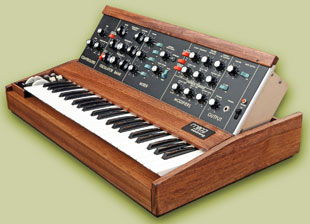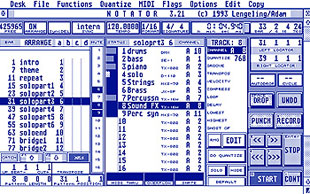![]() Midi has enjoyed a lot of press recently. In honour of its 30th birthday, it’s been in the news everywhere from tech blogs to the broadsheets, from Twitter to TV. And deservedly so...
Midi has enjoyed a lot of press recently. In honour of its 30th birthday, it’s been in the news everywhere from tech blogs to the broadsheets, from Twitter to TV. And deservedly so...
Against the odds, Midi has provided electronic music making with its lingua franca and rewritten the future of electronic musical instruments and music making. Thirty years ago, it was 1983 and Midi changed my life.
Happy birthday Midi – the Musical Instrument Digital Interface. It’s been interesting to trip back to The Year of Midi, when Pioneer 10 passed the orbit of Neptune, GPS was being prepared for publication access, Apple was in its infancy and synthesists were born, not made. Synthesisers had been unfailingly analogue – until the Yamaha DX7 brought FM synthesis algorithms out of John Chownings’s Stanford University lab and into the daylight, complete with a Midi implementation that anticipated the first Midi spec.
 But a lot of what I’ve been reading is, at best, incomplete or misleading. Too much of it is simply wrong, wrong, wrong...
But a lot of what I’ve been reading is, at best, incomplete or misleading. Too much of it is simply wrong, wrong, wrong...
Poor research or a further demonstration of the limitations of the internet as a reliable research tool? It’s hard to tell. I remember the first synth retrospective I wrote, on the Minimoog no less (Electronics & Music Maker, October 1985). I owned one, I loved it and I knew it well. I also had access to people who were involved in its development and launch. But the details of its history were frustratingly difficult to nail.
As has been well documented, the credit for getting Midi off the ground goes to Sequential Circuits founder Dave Smith, with his Prophet 5 becoming the first ‘Midi keyboard’ in 1978. It came at a time when the major players on the commercial synth scene all had their own interfaces, allowing their own synths, sequencers and drum machines to communicate (where necessary), control (where desirable) and sync (where essential). As much as they united proprietary systems, however, they denied other manufacturers’ kit from becoming part of them.
Among the Midi 30th posts I read was one on US ‘technology, science, art and culture’ site, The Verge. It’s an entertaining read – if you aren’t too particular about accuracy. Windows 1.0 appeared in 1983? Previously no practical way to communicate between electronic instruments? Midi unchanged for 30 years? It did a fair job of giving an historical context but it was well wide of the mark on Midi’s origins.
When I wrote my 1985 retrospective, Midi was two years into its development and the Minimoog had been out of production for four (for reference, ARP’s competing Odyssey was produced from 1972 to 1981). The Verge quoted Moog’s Open System (introduced on the Micromoog in 1975 – I had one of these too) as a prime Midi precursor. This was to completely overlook the CV/S-Trig (note pitch/trigger) interface offered by the Minimoog ten years earlier. It’s not as if the Minimoog is an obscure synth... schoolboy error.
Open standard
The other oversight in the mainstream Midi anniversary excitement is the real purpose of this post.
 The initial resistance to the introduction of a common comms system that allowed players to mix and match kit from different manufacturers was those companies’ wish to build a captive user base. Surely, they reasoned, an open system would be a disaster.
The initial resistance to the introduction of a common comms system that allowed players to mix and match kit from different manufacturers was those companies’ wish to build a captive user base. Surely, they reasoned, an open system would be a disaster.
Those that did smell disaster would have drawn comfort from the ‘real musicians’ community, who regarded Midi as a poor apology for learning to play an instrument – Musical Idiots Demand It, they sneered. Yeah, right.
Hats off to Dave Smith, then, for seeing the bigger picture. Although, to be fair, he couldn’t have seen all of it. Who could?
The first fallout of Midi was the creation of a whole new MI business area. Third-party manufacturers quickly appeared to provide Midi/CV interfaces, Midi routers and filters, and Midi conversions for pre-Midi synths like the one that Kenton Electronics did on my Roland Jupiter 8 – itself succeeded by the Jupiter 8A that came with Roland’s proprietary Digital Control Bus to communicate with the MC-4 and MC-8 microcomposers. We also got the first wave of Midi sequencing software, opening the door on a whole new way of composing, creating, recording and performing music. Among them, C-Lab’s 1987 Creator – released for the Atari ST, it has evolved to become Apple’s Logic. Paradigm shift, anyone?
The next chapter saw a power struggle within the Midi Manufacturers’ Association – with certain manufacturers accused of trying to ‘own’ Midi. It was a bit cloak-and-dagger for a while, but we got successive versions of Midi and the General Midi subset.
Today, if you’re a programmer, the Midi code is a bit of mess. But what else would you expect after 30 years of common ownership and extreme mission creep?
There’s a lesson here. A lesson for everyone involved in comms and interchange standards in all areas of audio and video. It’s instinctive to try to protect the user base you have, and locking out your competitors is an obvious strategy, but it’s not necessarily a good one. Take another look at Midi.
Thirty years on, I’m counting 30 reasons to celebrate Midi.